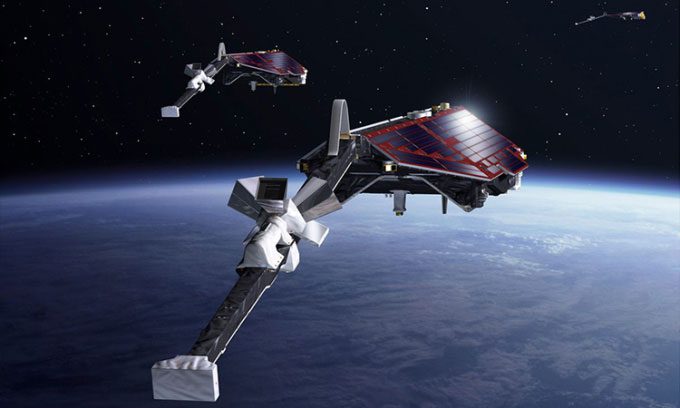The European satellite Alpha had to adjust its orbit to avoid severe space weather while also dodging an incoming piece of space debris.
The Earth’s atmosphere is influenced by the Sun. As the Sun enters a period of heightened activity in its 11-year cycle, space weather and ultraviolet light will become more extreme. High radiation heats the atmosphere, leading to an increase in the density of the upper atmosphere where satellites operate. This creates drag and can slow satellites to the point of causing them to fall to Earth.

Illustration of Swarm satellites in space. In reality, they are not that close together. (Photo: ESA)
To avoid a “premature death” in the atmosphere, the Swarm satellites need to adjust their orbits. This trio of satellites is part of a research program on Earth’s magnetic field by the European Space Agency (ESA), as reported by IFL Science on July 19.
While Bravo faced no issues since it was operating at a high altitude, the two satellites Alpha and Charlie had to move to a higher orbit. Their goal is to perform 25 adjustments over 10 weeks to reach a safe position.
Alpha needs to increase its altitude by an additional 45 km. However, a planned adjustment on June 30 had to be halted due to warnings that Alpha could collide with space debris within the next 8 hours. It is unclear what this debris is, but the collision risk was high enough to necessitate avoidance maneuvers.
The team of experts quickly began to address the situation, and after about 4 hours, they were ready to move the satellite to avoid the collision. However, the urgency of raising the orbit meant they had to schedule the next adjustment as soon as possible.
Alpha and Charlie need to maintain a relatively close distance to provide accurate observations. Therefore, if they do not fly on similar orbits, research will have to be halted. Fortunately, the responsible team successfully adjusted their orbits.
There is a significant amount of space debris surrounding Earth, and ESA typically has to move its satellites twice a year. The number of alerts is trending upwards, but not every alert leads to a trajectory adjustment. Each such maneuver must ensure that the satellite is not placed into an even more dangerous orbit, which requires careful planning by the experts.





















































